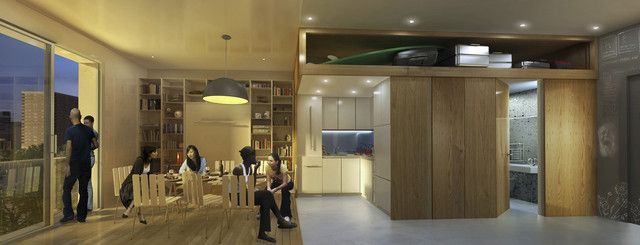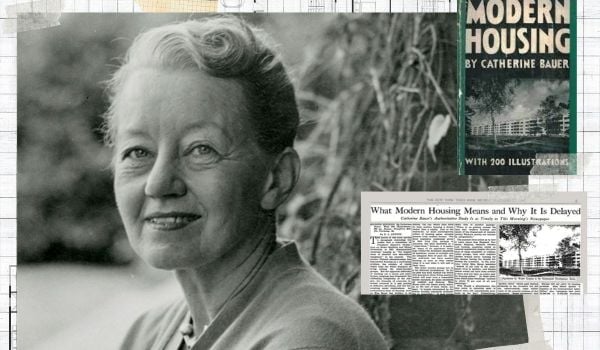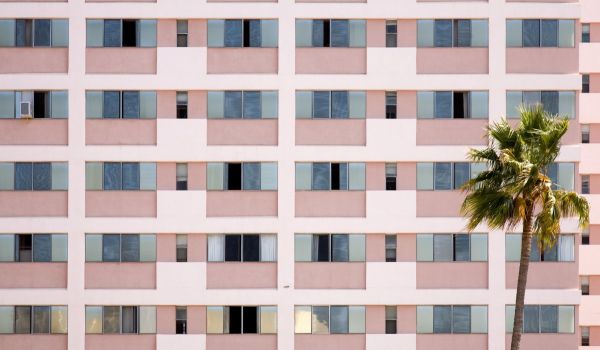Last week, New York City Mayor Michael Bloomberg made headlines unveiling a new prototype for a teeny-tiny apartment designed to fit the needs of single New Yorkers seeking affordable dwellings that actually allow for sunlight, as well as the occasional dinner party.
The design from Monadnock Development, the Actors Fund Housing Development Corp. and nArchitects — the winning entry in a city-sponsored competition, adAPT NYC — will have its first trial in a 55-unit Manhattan building developed on a site bought from the city at a discount price. The apartments in the Kips Bay building will range in size from 250 square feet to 370 square feet, with 22 of the 55 units set aside to be rented at affordable rates by tenants earning no more than $77,190 a year, and the remaining 60 percent renting at market rates.
Rents for the affordable units will start at $914 a month for those earning up to $38,344 a year and go up to $1,873 for those making $77,190 or less. The average studio rent on Manhattan’s East Side, where the new units will go, was $2,321 in December of 2012, according to Douglas Elliman Real Estate.
There is a practical reason why the “My Micro NY” design looks less like an Manhattan apartment than the lovechild of a dorm room and a CB2 showroom: Zoning. The city’s current zoning code requires a minimum of 400 square feet for all living spaces. Under the pilot program, the Bloomberg administration will waive some zoning regulations on the site to test the market for micro-units, the mayor’s office said.
The high cost of housing in New York is nothing new — a recent New York Times article about the squeeze on the Manhattan middle class quoted a 1907 article that proclaimed that soon “there will be no New Yorkers,” because of the city’s steep cost of living.
But what is new is the growth rate among singles and childless couples. The 2010 Census counted 1.8 million one- and two-person households, but only one million studios and one-bedroom apartments.
“The growth rate for one- and two-person households greatly exceeds that of households with three or more people, and addressing that housing challenge requires us to think creatively and beyond our current regulations,” Bloomberg said in a statement.
So, Bloomberg is building housing for the childless-professional demographic. A rendering shows a sleek apartment with a bright green surfboard stuffed into storage and books lining the walls. A bar slides out from behind a flat-screen television. This is not a place for growing families.
“It doesn’t really fit the need for families and for growing a family or staying long term in the city,” Matthew Dunbar, advocacy and community relations manager for HabitatNYC, the local branch of Habitat for Humanity, told the Gotham Gazette.
It’s not surprising Bloomberg took this approach. A man of the markets, he chose to address the housing need with deregulation — waiving the space minimums in the zoning code — rather than the more traditional way of simply creating more housing or new affordability regulations. It’s a creative response that will hopefully spawn more forward-thinking rejiggering of the city’s aged zoning code.
But his solution, which likely pleased Triumph of the City author Edward Glaeser and other fans of higher-density cities, has its sure and obvious limits.
In 2006, an internal study done by the Bloomberg administration found that 64 percent of people leaving the city cited housing costs as the number-one reason for departure, according to the New York Observer, which quoted the unpublished study in a 2009 article.
Would these people stay if they could live in a nicely designed shoebox?
Doubtful. The micro-unit is a part of solving the city’s affordability crisis, but a small part. Though the number of childless adults earning enough to afford rents north of $900 a month is large and growing, it is dwarfed by the number of people who live in larger families on smaller incomes. By making more options for the former group, we can hope is that the pressure on the housing market will be diffused and rents for all will drop. We can also hope that affordable, better-designed two- and three-bedrooms are also on the way.
















